Practicing the CBSE Sample Papers for Class 12 Applied Mathematics Set 4 allows you to get rid of exam fear and be confident to appear for the exam.
CBSE Sample Papers for Class 12 Applied Mathematics Set 4 with Solutions
Time Allowed: 3 hours
Maximum Marks: 80
General Instructions:
- This question paper contains five sections A, B, C, D and E. Each section is compulsory.
- Section – A carries 20 marks weightage, Section – B carries 10 marks weightage, Section – C carries 18 marks weightage, Section – D carries 20 marks weightage and Section – E carries 3 case-based with total weightage of 12 marks.
- Section -A: It comprises of 20 MCQs of 1 mark each.
- Section – B: It comprises of 5 VSA type questions of 2 marks each.
- Section – C: It comprises of 6 SA type of questions of 3 marks each.
- Section – D: It comprises of 4 LA type of questions of 5 marks each.
- Section – E: It has 3 case studies. Each case study comprises of 3 case-based questions, where 2 VSA type questions are of 1 mark each and 1 SA type question is of 2 marks. Internal choice is provided in 2 marks question in each case-study.
- Internal choice is provided in 2 questions in Section – B, 2 questions in Section – C, 2 questions in Section – D. You have to attempt only one of the alternatives in all such questions.
Section – A
All questions are compulsory. No internal choice is provided in this section
Question 1.
The value of 5 ![]() 11, where
11, where ![]() is multiplication modulo is: [1]
is multiplication modulo is: [1]
(A) – 1
(B) 0
(C) 7
(D) 9
Answer:
(C) 7
Explanation:
5![]() 11 = (5 x 11)mod 8
11 = (5 x 11)mod 8
= 55 mod 8
= 7
Question 2.
If the present time is 8.40 pm, then the time after 876\(\frac { 1 }{ 2 }\) hours will be: [1]
(A) 8.40 am
(B) 9.10 am
(C) 6.10 pm
(D) 10.40 pm
Answer:
(B) 9.10 am
Explanation: ∵ 876 (mod 24) = 12
∴ 8.40 pm will change to 8.40 am after 12 hours, further after 30 minutes the time will be 9.10 am.
Question 3.
If a and b are positive integers and \(\frac { a-b }{ 6.25 }\) = \(\frac { 8 }{ 2.5 }\), then. [1]
(A) b > a
(B) b < a
(C) b = a
(D) b ≥ a
Answer:
(B) b < a Explanation: Given, \(\frac { a-b }{ 6.25 }\) = \(\frac { 8 }{ 2.5 }\) a – b = \(\frac { 6.25×8 }{ 2.5 }\) a – b = 20 a = 20 + b Hence, a > b or b < a
![]()
Question 4.
The reciprocal of series compound amount factor is classified as: [1]
(A) series fund factor
(B) sinking fund factor
(C) annuity fund factor
(D) nominal fund factor
Answer:
(B) sinking fund factor
Explanation: Sinking-fund factor is the reciprocal of interest factors for compounding annuities.
Question 5.
The portion of formula used to calculate equal payment annuity [(1 + i)n – 1]/i(1 + i)n is classified as: [1]
(A) series future growth factor
(B) series present worth factor
(C) series future worth factor
(D) series present growth factor
Answer:
(B) series present worth factor
Question 6.
The present value of perpetuity of ₹ 750 payable at the end of the beginning of each year, if money is worth 5% p.a. is. [1]
(A) ₹ 14250
(B) ₹ 15000
(C) ₹ 15750
(D) None of these
Answer:
(C) ₹ 15750
Explanation: Here,
P = R + \(\frac { R }{ i }\)
Where, R = 750, i = \(\frac { 5 }{ 100 }\) = 0.05
P = 750 + \(\frac { 750 }{ 0.050 }\)
= ₹ 15,750
Question 7.
The time period in which an asset is expected to be functional and fit for the purpose is called: [1]
(A) Term
(B) Useful life
(C) Span
(D) None of these
Answer:
(B) Useful life
Explanation: Useful life is the estimated lifespan of a depreciable fixed assets, during which it can be expected to contribute to company operations.
Question 8.
In a 3 x 3 matrix A, value of a12c13 + a22c23 + a32c33, where c is the cofactor of aij is: [1]
(A) 0
(B) – 1
(C) 1
(D) |A|
Answer:
(C) 1
Explanation: The summation of product of aij of 2nd column with corresponding cij of 3 column = 0
Question 9.
If two square matrices A and B are such that |AB| = 12 and |B| = – 4, then value of |A| is: [1]
(A) 8
(B) – 8
(C) – 3
(D) 16
Answer:
(C) – 3
Explanation:
|AB| = 12
|A| |B| = 12
– 4 |A| = 12
|A| = – 3
Question 10.
If matrix A is given by A = [aij]2×2 where aij = i + j, then A is equal to: [1]
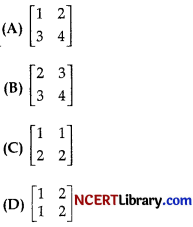
Answer:
![]()
Explanation: Here,
a11 = 1 + 1 = 2
a12 = 1 + 2 = 3
a21 = 2 + 1 = 3
And a22 = 2 + 2 = 4

![]()
Question 11.
The following are the movement(s) in the secular trend. [1]
(A) Smooth
(B) Regular
(C) Steady
(D) All of these
Answer:
(D) All of these
Explanation: Secular trend is that component of the time series which gives the general tendency of the data for a long periods. It is smooth, regular and long term (steady) movement of a series.
Question 12.
Let X denotes the number of hours a student devotes to self-study during a randomly selected school day. The probability that X takes the value z where k is some unknown constant is: [1]

The probability that a student studies at least 3 hours on a particular day is:
(A) \(\frac { 1 }{ 7 }\)
(B) \(\frac { 2 }{ 7 }\)
(C) \(\frac { 3 }{ 7 }\)
(D) \(\frac { 1 }{ 2 }\)
Answer:
(C) \(\frac { 3 }{ 7 }\)
Explanation: ∑ pi = 1
k + 2k + 2k + k + 0 = 1
7k = 1
k = \(\frac { 1 }{ 7 }\)
Now, P(x ≥ 3) = 3k = 3 x \(\frac { 1 }{ 7 }\)
= \(\frac { 3 }{ 7 }\)
Question 13.
Find the expectation of a random variable X. [1]

(A) 0.5
(B) 1.5
(C) 2.5
(D) 3.5
Answer:
(B) 1.5
E(X) = (\(\frac { 1 }{ 6 }\)) + 1(\(\frac { 2 }{ 6 }\)) + 2(\(\frac { 2 }{ 6 }\)) + 3(\(\frac { 1 }{ 6 }\))
= 0 + \(\frac { 2 }{ 6 }\) + \(\frac { 4 }{ 6 }\) + \(\frac { 3 }{ 6 }\)
= \(\frac { 9 }{ 6 }\) = \(\frac { 3 }{ 2 }\) = 1.5
Question 14.
A river passing near a town floods it on an average twice every lo years. Assuming Poisson distribution find the probability that the town faces flooding at least once in 10 years. (Given e-2 = 0.1353). [1]
(A) 0.0198
(B) 0.1353
(C) 0.5657
(D) 0.647
Answer:
(D) 0.647
Explanation:
P(X ≥ 1) = 1 – P(0)

= 1 – e-2
= 0. 8647
![]()
Question 15.
E(X) = npq is for which distribution? [1]
(A) Bernoulli’s
(B) Binomial
(C) Poisson’s
(D) None of these
Answer:
(B) Binomial
Explanation:
In Binomial distribution, probability of success is given by p and that of failure is given by q and the event is done n times. The mean of the distribution is given by npq.
Question 16.
The order and degree (if defined) of differential equation y dx + [ x log( \(\frac { y }{ x }\)) – 2x] dy = 0 are: [1]
(A) 1,1
(B) 1,0
(C) 0, 1
(D) Not defined
Answer:
(A) 1,1
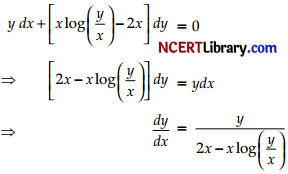
The highest order derivative present is \(\frac { dy }{ dx }\) and it is raised to power 1. So, its order is 1 and degree is also 1.
Question 17.
The interval on which the function
f(x) = 2x3 + 9x2 + 12x – 1 is decreasing is: [1]
(A) (-1,∞)
(B) (-2,-1)
(C) (-∞,-2)
(D) (-1,1)
Answer:
(B) (-2,-1)
Explanation: Given that,
f(x) = 2x3 + 9x2 + 12x – 1
f’(x) = 6x2 + 18x + 12
= 6 (x2 + 3x + 2)
= 6 (x + 2)(x + 1)
So, f’(x) ≤ 0 , for decreasing.
On drawing number line as below:
![]()
We see that f(x) is decreasing in (- 2, – 1)
Question 18.
Find the slop of tangent to the curve y = 3x2 + x + 4 at x = 3. [1]
(A) 19
(B) 1.9
(C) 18
(D) 17
Answer:
(A) 19
Explanation: The slope of tangent at x = 3 is given by
\(\frac { dy }{ dx }\)|x=3 = 6x + 1|x=3
= 18 + 1
= 19
DIRECTION: For questions 19 and 20, two statements are given – one labelled Assertion(A) and the other labelled
Reason (R). Select the correct answer to these questions from the codes (A), (B), (C) and (D) as given below:
(A) Both assertion (A) and reason (R) are true and reason (R) is the correct explanation of assertion (A).
(B) Both assertion (A) and reason (R) are true and reason (R) is not the correct explanation of assertion (A).
(C) Assertion (A) is true but reason (R) is false.
(D) Assertion (A) is false but reason (R) is true.
![]()
Question 19.
Assertion (A): The rate of interest for which the present value of perpetuity of ₹ 500 payable at end of each quarter be ₹ 40,000 is 5%.
Reason (R): Apply formula, P = \(\frac { R }{ i }\). [1]
Answer:
Option (A) is correct.
Explanation: Let rate of interest be r% per annum,
then i = \(\frac { r }{ 4×100 }\) = \(\frac { r }{ 400 }\)
Given, R = ₹ 500 and P = ₹ 40,000
P = \(\frac { R }{ i }\)
⇒ i = \(\frac { R }{ P }\)
⇒ \(\frac { r }{ 4×100 }\) = \(\frac { 500 }{ 40,000 }\)
⇒ r = \(\frac { 2,00,000 }{ 40,000 }\) = 5%
Question 20.
Assertion (A): The total expenditure (in ₹) required for providing the cheap edition of a book for poor and deserving students is given by C(x) = 3x2 + 36x, where x is the number of set of books. If the marginal expenditure is defined as \(\frac { dC }{ dx }\), the marginal expenditure required for 1200 such sets is ₹ 7,23e. [1]
Reason (R): Marginal cost is (\(\frac { dC }{ dx }\))x=1200
Answer:
Option (A) is correct.
Explanation: Here, C(x) = 3x2 + 36x, where x is the number of sets of book
\(\frac { dC }{ dx }\) = 6x + 36
(\(\frac { dC }{ dx }\))x=1200 = 6(1200) + 36 = 7,236
So, the marginal cost of books for 1200 such sets
= ₹ 7,236
Section – B
All questions are compulsory. In case of internal choice, attempt any one question only
Question 21.

find k so that A2 = 5A + kl.
If A is a square matrix satisfying A’ A = I write the value of |A|. [2]
Answer:
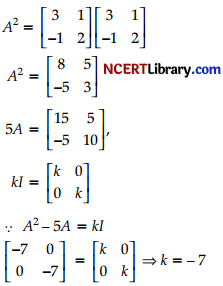
OR
Iet the value of |A| = x
Since, |A| = |A| and |I| = 1
Given, AA’ = I
∴ |AA’| = |I|
⇒ |A||A’| = |I| [|AA’| = |A||A’|]
⇒ x . x = 1
⇒ (x2 – 1) = 0
⇒ (x – 1)(x + 1) = 0
⇒ x = ± 1
∴ Value of |A| = ± 1
![]()
Question 22.
Compute the seasonal indices by 3-years moving averages from the given data of production of paper (in thousand tons) [2]
| Year | 2011 | 2012 | 2013 | 2014 | 2015 | 2016 | 2017 | 2018 | 2019 | 2020 |
| Index number | 2450 | 1470 | 2150 | 1800 | 1210 | 1950 | 2300 | 2500 | 2480 | 2680 |
Answer:
Seasonal indices are as follows:
| Year | Index number | 3 year moving totals | 3 year moving average |
| 2011 | 2450 | – | – |
| 2012 | 1470 | 6070 | 2023.33 |
| 2013 | 2150 | 5420 | 1806.66 |
| 2014 | 1800 | 5160 | 1720 |
| 2015 | 1210 | 4950 | 1650 |
| 2016 | 1950 | 5460 | 1820 |
| 2017 | 2300 | 6750 | 2250 |
| 2018 | 2500 | 7280 | 2426.66 |
| 2019 | 2450 | 7660 | 2553.33 |
| 2020 | 2680 | – | – |
Question 23.
The standard deviation of a sample is 6.3. Determine the size of the sample if the standard error is 0.6 and population standard deviation is 6. [2]
Answer:
Sample size = n
Sample S.D. (s) = 6.3
Population S.D. (σ) = 6
Standard Error, S.E. = 0.6
The standard error for sample S.D. is given by
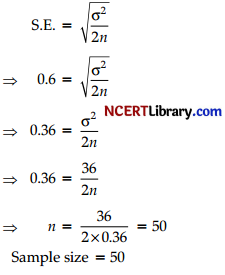
Question 24.
Eight coins are tossed together. The probability of getting exactly 3 heads. [2]
Answer:
We know that, probability distribution
P(X = r) = nCr (p)r qn-r
Here, n = 8, r = 3, p = \(\frac { 1 }{ 2 }\) and q = \(\frac { 1 }{ 2 }\)
∴ Required probability = 8C3 ( \(\frac { 1 }{ 2 }\))3 ( \(\frac { 1 }{ 2 }\))8-3
= \(\frac { 8! }{ 5!3! }\) ( \(\frac { 1 }{ 2 }\))8
= \(\frac { 8.7.6 }{ 3.2 }\) \(\frac{1}{2^8}\) = \(\frac { 7 }{ 32 }\)
Question 25.
Find the area of region bounded by the curve x = 2y + 3, Y – axis and the lines y = 1 and y = – 1. [2]
OR
Given y = \(\frac{x}{x^2+1}\), then find the value of second derivative at x = 1.
Answer:
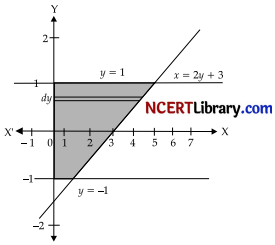
From the figure, area of the shaded region,

= [ 1 + 3 – 1 + 3]
= 6 sq. units
OR
Let y = \(\frac{x}{x^2+1}\) then
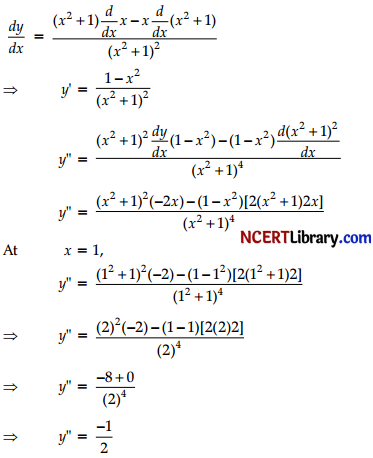
Section – C
All questions are compulsory. In case of internal choice, attempt any one question only
Question 26.
Solve the following LPP graphically: [3]
Minimize Z = 5x + 10 y
Subject to x + 2 ≤ 120
Constraints x + y ≥ 60
x – 2y ≥ 0
and x, y ≥ 0
OR
A firm has to transport at least 1200 packages daily using large vans which carry 200 packages each and small vans which can take 80 packages each. The cost for engaging each large van is ₹ 400 and each small van is ₹ 200. Not more than ₹ 3,000 is to be spent daily on the job and the number of large vans cannot exceed the number of small vans. Formulate this problem as a LPP given that the objective is to minimize cost. [3]
Answer:
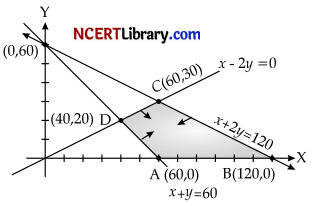
x + y = 60
Z = 5x + by
Z|A(60,0) = 300 → Minimum
Z|B(120,0) = 600
Z|C(60,30) = 600
Z|D(40,20) = 400
Minimum value, Z = 300 at x = 60, y = 0
OR
Let the number of large vans and small vans used for transporting the packages be x and y, respectively. It is given that the cost of engaging each large van is ₹ 400 and each small van is ₹ 200.
Cost of engaging x large van is ₹ 400 and each small van is ₹ 200.
Cost of engaging x large vans = ₹ 400x
Cost of engaging y small vans = ₹ 200y
Let Z be the total cost of engaging x large vans and y small vans.
∴ Z = ₹ (400x + 200y)
The firm has to transport at least 1200 packages daily u sing large vans which carry 200 packages each and small vans which can take 80 packages each.
So, 200x + 80y ≥ 1200
Not more than ₹ 3000 is to be spent daily on the transport.
So, 400x + 200y ≤ 3000
Also, the number of large vans cannot exceed the number of small vans.
∴ x ≤ y
Thus, the linear programming problem of the problem is
Min.Z = ₹ (400x + 200y)
Subject to constraints
200x + 80y ≥ 1200
400x + 200y ≤ 3000
x ≤ y
x ≥ 0, y ≥ 0
![]()
Question 27.
Pipe A and B can fill a tank in 5 hours and 6 hours respectively. Pipe C can empty it in 12 hours. If all the three pipes are opened together, then the time taken to fill the tank is: [3]
OR
Find the remainder when 561 is divided by 7.
Answer:
Here, LCM of 5,6 and 12 is 60.
i.e., LCM(5, 6, 12) = 60
Suppose capacity of the tank is 60 l.
Then, quantity filled by pipe A in 1 hr = \(\frac { 60 }{ 2 }\) = 12l
Quantity filled by pipe B in 1 hr = \(\frac { 60 }{ 6 }\) = 10 l
Quantity emptied by pipe C in 1 hr = \(\frac { 60 }{ 12 }\) = 5l
So,quantity filled by all three pipes in 1 hr
= (12 + 10 – 5)l
= 171
Required time = \(\frac { 60 }{ 17 }\) = 3 \(\frac { 9 }{ 17 }\) hours
OR
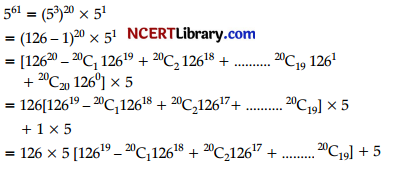
Here, 126 x 5 = 630, which is divisible by 7, thus remainder is 5. 3
Question 28.
Roshan needs ₹ 5,000 in three years. How much should he deposit each month in an account that pays 8% compounded monthly in order to achieve his goal? [Given, (1.0066)36 = 1.2672]. [3]
Answer:
If Roshan saves ₹ P per month, after three years he will have
![]()
Here, A = ₹ 5000, i = \(\frac { 8 }{ 100×12 }\) = 0.0066,
n = 3 x 12 = 36
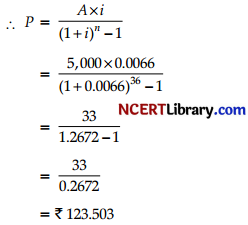
So ₹ 123.503 should be deposited each month.
Question 29.
Find the present value of an annuity of ₹ 1900 payable at the end of each year for 3 years if money is worth 5.6 %compounded annually. (Given (1.056)-3 0.8492]. [3]
Answer:
Present value of ordinary annuity
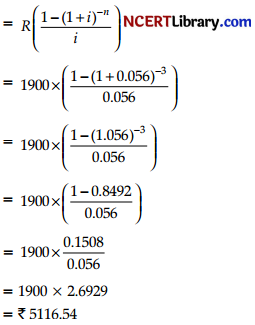
is the present value.
Question 30.
Consider the following hypothesis test:
H0 = µ = 15
H1 = µ ≠ 15
A sample of 50 provided a sample mean of 14.15. The population standard deviation is 3. [3]
- Compute the value of the test statistics.
- What is the p-value?
- At ∝ = 0.05, what is your conclusion?
Answer:
(i) Given µ0 = 15, n = 50, \(\bar{x}\) = 14.15, σ = 3
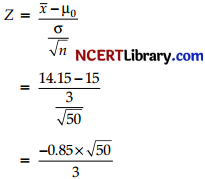
= -2.003
Z = – 2
(ii) Since, Z = – 2 < 0
So, p-value = 2
(Area under the standard normal curve to the left of Z)
= 2 x 0.0228
[Using table of standard normal distribution]
∴ p – value = 0.0456
(iii) Since, p-value <0.05 [as given ∝ = 0.05]
So, hypothesis is rejected.
Question 31.
Fit a straight line trend by the method of least squares to the data given below: [3]
| Years | 2012 | 2013 | 2014 | 2015 | 2016 | 2017 | 2018 |
| Sales (in tones) | 9 | 11 | 13 | 12 | 14 | 15 | 17 |
Answer:
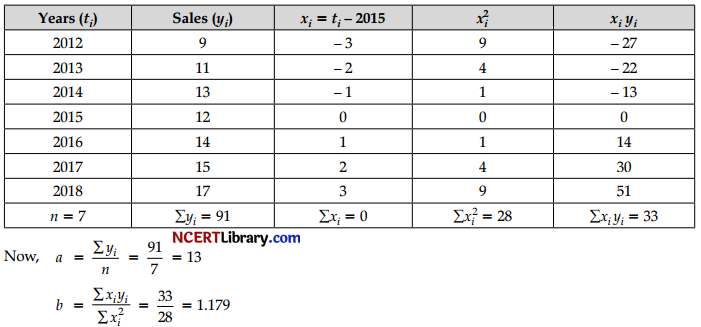
The equation of the straight line trend is
y = a + bx
∴ y = 13 + 1.179 x
Section – D
All questions are compulsory. In case of internal choice, attempt any one question only
Question 32.
(i) A can contains a mixture of two liquids A and B in the ratio 7: 5. When 9 litres of mixture are drawn off and can is filled with B, the ratio of A and B becomes 7: 9. How many litres A was contained by the can initially?
(ii) A man can row 40 km upstream and 55 km downstream in 13 hours. Also, he can row 30 km upstream and 44 km downstream in 10 hours. Find the speed of the man in still water and speed of the current. [5]
Answer:
(i) Suppose the can initially contains 7x and 5x litres of mixtures A and B, respectively.
Quantity of A in mixture left = (7x – \(\frac { 7 }{ 12 }\) x 9) litres
= ( 7 x – \(\frac { 21 }{ 4 }\)) litres
Quantity of B in mixture left = (15x – \(\frac { 5 }{ 12 }\) x 9)htres
= (5x – \(\frac { 15 }{ 4 }\)) litres

\(\frac { 28x-21 }{ 20x+21 }\) = \(\frac { 7 }{ 9 }\)
252x – 189 = 140x + 147
112x = 336
x = 3
So, the can contained 21 litres of A.
(ii) Let rate upstream = x km/h and rate downstream = y km/h
Then, \(\frac { 40 }{ x }\) + \(\frac { 55 }{ y }\) = 13 ……………..(i)
and \(\frac { 30 }{ x }\) + \(\frac { 44 }{ y }\) = 10 …………..(ii)
Multiplying (ii) by 4 and (1) by 3 and subtracting, we get
\(\frac { 11 }{ y }\) = 1 or y =11
Substituting y = 11 in (i), we geti = 5
Rate in still water = \(\frac { 1 }{ 2 }\) (11 + 5) km/h =8km/h
Rate of current = \(\frac { 1 }{ 2 }\)(11 – 5) km/h = 3km/h
![]()
Question 33.
Find matrix X if:

OR

Find A-1. Use it to solve the system of equations. [5]
Hence, solve the system of equations:
2x – 3y + 5z = 11
3x + 2y – 4z = – 5
x + y – 2z = – 3
Answer:
Clearly order of X is 3 X 2
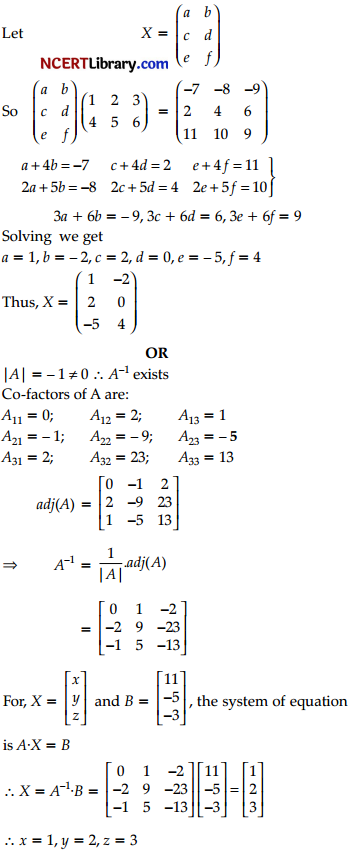
Question 34.
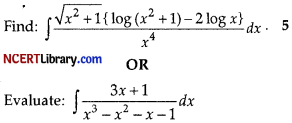
Answer:
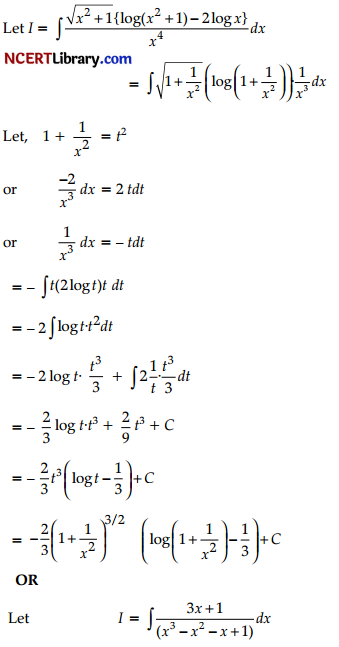
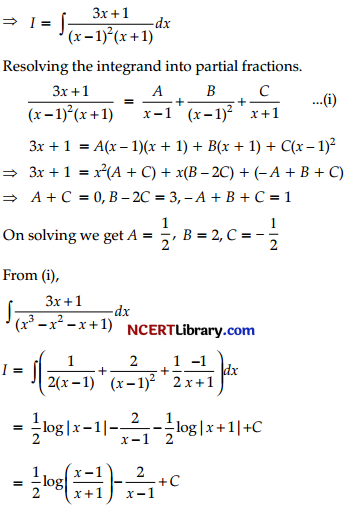
Question 35.
A company manufacturers two types of products A and B. Each unit of A requires 3 gram of nickel and 1 gram of chromium, while each unit of B requires 1 gram of nickel and 2 gram of chromium. The firm can produce 9 gram of nickel and 8 grams of chromium. The profit is ₹ 40 on each unit of product of type A and ₹ 50 on each unit of type B. How many units of each type should the company manufactures so as to earn maximum profit? Use linear programming to find the solution. [5]
Answer:
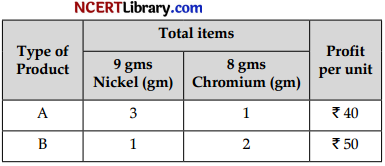
Let x = Number of units of type A
y = Number of units of type B
Maximize Z = 40x + 50y
Sub ject to the constraints,
3x + y ≤ 9
x + 2y ≤ 8
and x ≥ 0,y ≥ 0
Consider the equation,
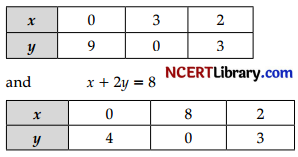
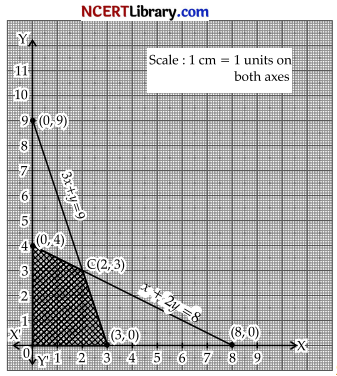
Shaded region in the diagram represents the feasible solution.
Now, we can determine the maximum value of Z by evaluating the value of Z at the four points (vertices) as shown below
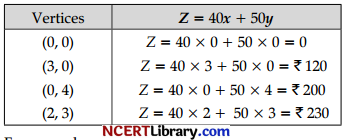
From graph,
Maximum profit, Z = ₹ 230
∴ Number of units of type A is 2 and number of units of type B is 3.
Section – E
All questions are compulsory. In case of internal choice, attempt any one question only
CASE STUDY – I
Question 36.
Rakesh and Kartik are final year engineering students. Both are selected in their campus interviews and got placement in a reputed company. But both of them decide to start their own business. For this they are surveying the market. During their survey they find the demand curve for a certain item is
p = D(q) = \(\frac { 20 }{ q+1 }\)
and the supply curve is
p = S(q) q + 2.

(i) Find equilibrium quantity? [1]
(ii) Find equilibrium price? [1]
(iii) Find consumer’s profit. [2]
OR
Find producer’s profit. [2]
Answer:
(i) At the equilibrium point, supply and demand curves meet.
D(q) = S(q).
\(\frac { 20 }{ q+1 }\) = q +2.
Clearing the denominator gives 20 = (q + 1)(q + 2),
which simplifies to q2 + 3q – 18 = 0.
The positive solution gives the equilibrium quantity qe = 3.
(ii) Put q = 3 in D(q) or S(q) to get equilibrium price (pe)
S(3) = 3 + 2 = 5
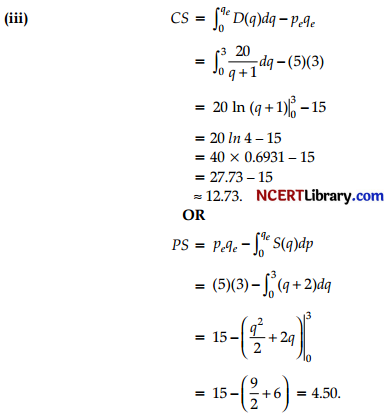
CASE STUDY-II
![]()
Question 37.
Three friends Rohan, Ajay and Sarneer were playing cards. They were trying to learn new games with cards. While playing the different games with cards, Sameer was thinking about the lesson of probability which was taught in yesterday’s class where the teacher told about the probability of drawing different cards in different situations. Soon, he came up with the problem of probability in which two cards were drawn simultaneously (or successively without replacement) from a well shuffled pack of 52 cards.

Based on the above information answer the following questions:
(i) Find the probability of drawing one king and one non-king card. [1]
(ii) Find the probability of drawing two king cards. [1]
(iii) Find the mean of the probability distribution. [2]
OR
Find the variance of the probability distribution. [2]
Answer:
(i) Here, X = no. of kings = 0, 1,2
P(X = 1) = P(one king and one non-king)
= \(\frac { 4 }{ 52 }\) x \(\frac { 48 }{ 51 }\) x 2 = \(\frac { 32 }{ 221 }\)
(ii) P(X = 2) = P(two kings) = \(\frac { 4 }{ 52 }\) x \(\frac { 3 }{ 51 }\) = \(\frac { 1 }{ 221 }\)
(iii) Probability distribution is given by
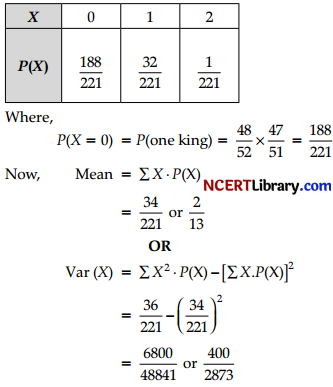
CASE STUDY-III
Question 38.
Ajay is a service man. He lives in a joint family. There are 6 members in his family. He is planning to purchase a car so he is searching for a bank for a loan. He take a loan of ₹ 2,50,000 at the interest rate of 6% p.a. compounded
monthly is to be amortize by equal payment at the end of each month for 5 years. Given that (1.005)60 = 1.3489, (1.005)21 = 1.1104.

(i) Find the size of the each monthly payment. [2]
OR
Find the principal amount paid in 40th payment. [2]
(ii) Write the formula for principal outstanding at beginning of 40th month. [1]
(iii) Find the total interest paid. [1]
Answer:
(i) Given, P = ₹ 2,50,000
i = \(\frac { 6 }{ 12 x 100 }\)
= 0.005
and, n = 5 x 12
= 60
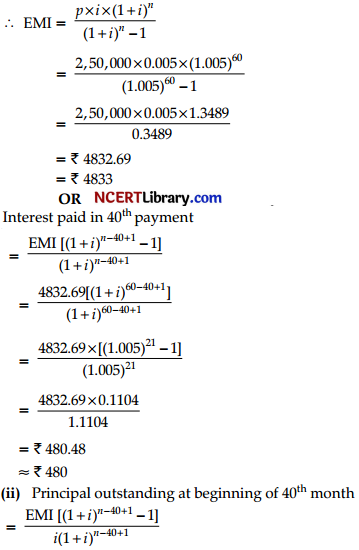
Where, n = 60 and i = 0.005
(iii) Total interest paid
= 60 x 4832.69 – 250000
= 289961.40 – 250000
= ₹ 39961.40
≈ ₹ 39961